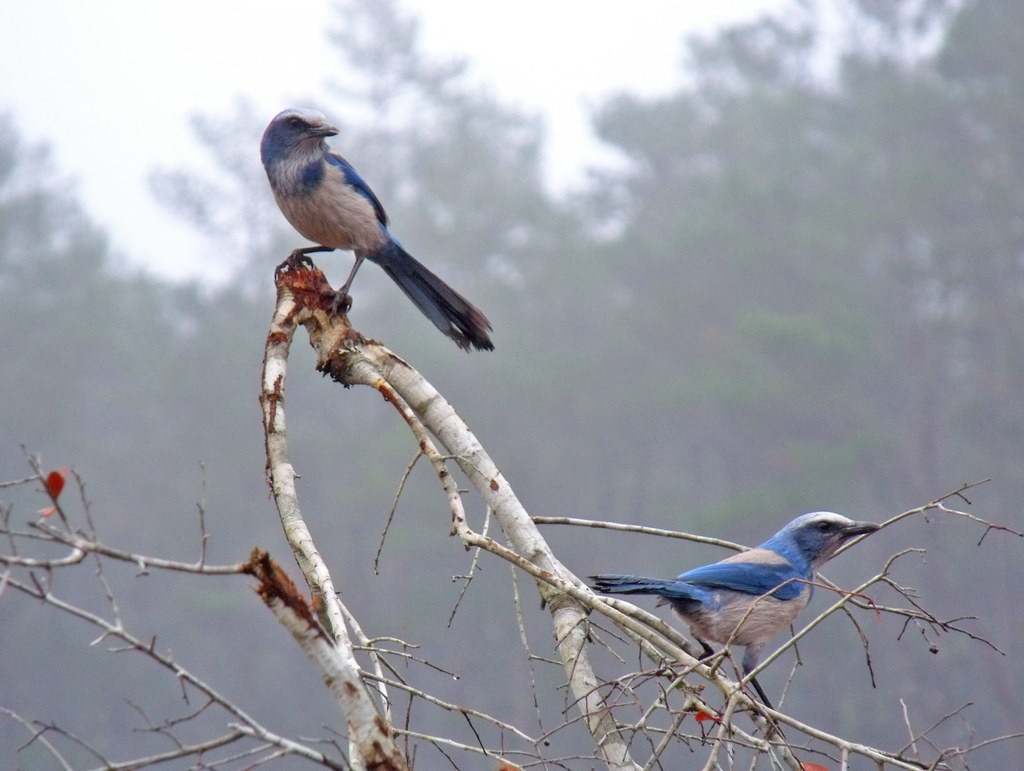An extraordinary type of bird found only in the Sunshine State may be exemplary models when it comes to the importance of two things that are vital to longterm health and happiness among humans: family time and socializing with others. Researchers from the Archbold Biologoical Station in Florida recently studied the Florida scrub jay. They made some fascinating discoveries about their unique, human-like behavior.
Learning about the Florida scrub jay

These beautiful blue birds are naturally monogamous creatures that like to settle down with one mate and raise a family. In most bird species, once the kids are old enough they leave the nest in pursuit of their own procreation. Scrub jays, however, are unique. Some recently-matured scrub jays actually put off “moving out” and looking for their own mate to help out at home. Especially if their mom and dad still need some help taking care of their younger siblings. These stay-at-home older siblings are referred to as “helpers” by researchers. They put off their search for a mate while many of their peers around the same age without younger siblings leave the nest and spend the majority of their time in pursuit of a mate and nest of their own. These scrub jays with reproduction on the mind are referred to as “breeders.”
Related: Audubon’s Jay Watch Hits 20th Anniversary
Despite the fact that helpers are stuck living at home, they nonetheless intend to find a mate eventually. So, helpers tend to cast a wider net in their interactions and movements in comparison to breeders who usually focus on building their own new nest and finding a mate close by.
“If helpers want to become breeders, they need their own territory and mate. In addition to helping their parents, they make forays away from home, presumably looking for available territories and potential mates. This increases the number of other birds that helpers associate with and the helpers’ importance in connecting individuals with one another,” explains lead author Dr. Angela Tringali, of the Archbold Biological Station, in a media release.
According to the research team, helpers usually know 38% more individual “associates” than breeders, and breeders are 48% more “cliquish.”
The study’s authors examined the social lives and behaviors of Florida scrub jays in 2018, a year that for whatever reason, saw these birds have unusually low reproductive success. Many breeders ended up not nesting at all that year, and the ones that did began later than normal. Here’s where things get interesting: due to this lack of reproductive success, breeders in 2018 started socializing more often with more birds, acting essentially like helpers. The breeders didn’t have any young to care for, or in many cases a nest at all. Instead they decided to socialize more outside of their immediate circle.
This behavior, researchers say, indicates that socializing is important to scrub jays beyond just a means to biological end. In summation, these observations have led the research team to conclude that many scrub jay breeders would like to socialize just as much helpers. But they just don’t have the time most years.

“We have tended to frame foray behavior strictly as a strategy for finding a territory or mate, but this analysis demonstrates that when not tending an active nest, breeders also will foray beyond their territories. Maintaining extra-group relationships may reduce the costs of territory defense, predation risk, or the time spent in vigilance, and enhance knowledge of the status of neighboring territories,” comments Dr. Reed Bowman, Research Director of the Avian Ecology Program at Archbold.
Researchers admit that their observations in 2018 were a bit hindered, consisting of “snapshots in time” taken during bi-weekly visits to scrub jay territory in Florida. Moving forward, they would like to get a more complete idea of the birds’ interaction patterns.
“We are completing a pilot project tracking scrub-jays tagged with a new technology of transmitters whose signals are received by a grid of receivers. We will know the exact location of multiple scrub-jays throughout the day, which will enable us to answer questions about social interactions in more detail and better understand habitat use, movement, and dispersal,” Dr. Bowman says.




























